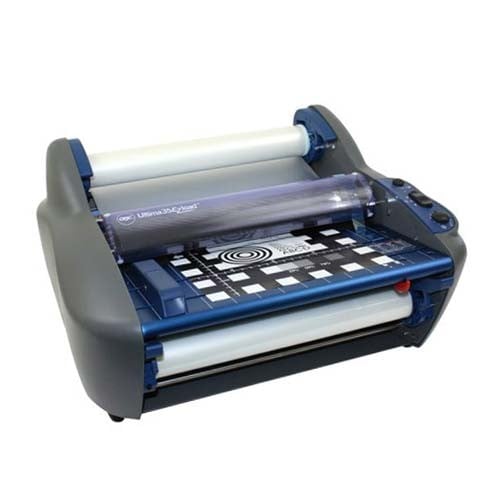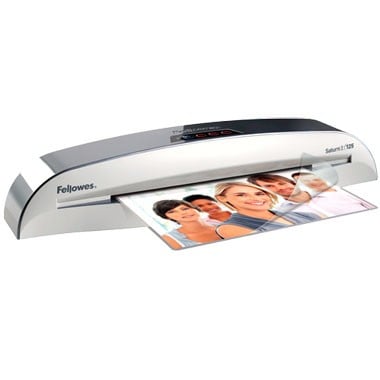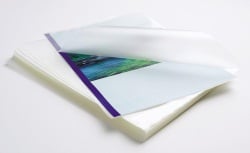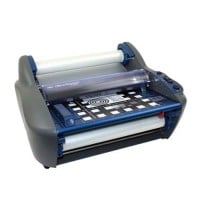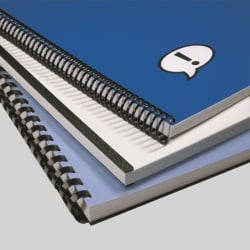MyBinding Knowledge Base
- Binding (248 Article)
- General Binding (42)
- Plastic Comb Binding (57)
- Fastback Binding (59)
- Perfect Binding (2)
- Modular Punching (8)
- Zipbind (3)
- Twin Loop Wire (13)
- Coil Binding (22)
- Thermal Binding (14)
- Strip Binding (1)
- VeloBind (4)
- Binding Covers (14)
- Proclick Binding (10)
- SureBind (4)
- Screw Post (2)
- Hole Punches (2)
- Staplers (4)
- Komtrak Insprial Binding (2)
- Paper (1)
- Rhin-O-Tuff (5)
- Binding Machines Comparison (17)
- Laminating (109 Article)
- General Laminating (26)
- Roll Lamination (16)
- Pouch Lamination (36)
- Pouch Board Laminator (3)
- School Laminator (3)
- Foil Laminating (3)
- Royal Sovereign Laminators (10)
- Laminators Comparison (3)
- Boards (11 Article)
- Bulletin Boards (3)
- Whiteboards (5)
- Chalkboards (1)
- Paper Shredders (44 Article)
- General Shredding (35)
- Industrial Shredders (1)
- Cross-Cut Shredders (2)
- Cardboard Shredders (1)
- Multimedia Shredders (1)
- Personal Shredders (1)
- High Security Shredders (2)
- Ring Binders (9 Article)
- Specialty Binders (2)
- Reinforced Paper (1)
- Health Care Punched Paper (1)
- Perforated Paper (2)
- View Binders (1)
- Index Tabs (9 Article)
- Index Tab Dividers (2)
- Copier Tabs (4)
- Pocket Folders (1)
- Custom Index Tabs (1)
- Pre-Printed Index Tabs (1)
- Paper Handling (37 Article)
- Paper Folders (9)
- Paper Joggers (2)
- Guillotine Cutters (4)
- Rotary Trimmer (3)
- Electronic Paper Cutters (1)
- Corner Rounders (2)
- Paper Scoring (2)
- Paper Drill (2)
- Booklet Makers (3)
- Stack Cutters (1)
- Paper Handling Equipment Comparison (5)
- ID Accessories (12 Article)
- Badge Holder (1)
- Lanyards (8)
- Badge Reels (1)
receive
$5off
*On order $25 or more.
What features should I look for when buying a coil binding machine?
Spiral coil binding is one of the most popular binding styles available on the market. The flexibility along with the huge number of colors that are offered in coil binding supplies make it a favorite binding style for all types of organizations. Perhaps you have seen coil binding somewhere in the workplace and are considering it for your organization. More than likely, it will be an excellent choice for your needs. However, here are six things that you need to know before you rush out and buy a coil binding machine:
- Although coil binding supplies come in diameters up to 50mm for books that are as thick as 2”, spiral coil binding documents that are larger than 1” can be very difficult. Binding books with large size coil is somewhat like trying to put a slinky on the edge of a book. In addition to the coil being very large and difficult to handle, the spine of the book will also have to be curved so that the path for the coil is rounded to match the diameter of the coil. This can be pretty tricky and time consuming if you don’t have special tools for inserting the coil.
- Almost all spiral coil on the market are designed for a 4:1 pitch coil binding machine. This simply means that the hole pattern used has 4 holes per inch. Coil is also available for 3:1 pitch binding patterns and 5:1 patterns but is not nearly as common. Generally, it is best to stick to the standard 4:1 pitch hole pattern unless you have a compelling reason to use a different pattern. Most coil binding machines punch round holes for the documents. However, some coil binding machines punch oversized oval holes to make inserting larger coils easier.
- Spiral coil is available in almost any length imaginable up to 36” in length. This makes it the ideal choice for binding large size documents. If you are planning on using coil to bind large size documents you will need to make sure that you coil binding machine has an open throat and preferably fully disengageable dies. This will allow you to set your machine up to make sure that you don’t have a half hole hanging off the edge of your paper.
- Standard spiral coil binding supplies come in 12” lengths for 11” documents. The extra length is cut off during the coil crimping process. If you plan on binding documents that are shorter or longer than 11”, you want to give yourself at least a half inch and preferably an inch to make sure that you have enough coil to cut off during the crimping process.
- You will notice that many spiral coil binding machines have a set of rollers on the front or the top of them. These rollers are used to help spin the coil through the holes on the edge of the document. True manual binding machines that do not have these rollers require you to spin the coil onto the book by hand. For short runs, this shouldn’t be a problem. However, for higher volume applications spinning the coil onto the book could become very tedious. For this reason, it is usually best to buy a machine with an integrated coil inserter or buy a standalone inserter to go along with your punch.
- In order to make sure that the coil doesn’t spin back off your documents after they are bound you will need to crimp the ends of the coil. A special pair of coil crimper pliers is usually used to cut off the end of the coil and bend over the end of the coil so that it won’t spin off the book. Using the pliers can be a little bit tricky and take some practice. Keep in mind that the red dot on the crimpers is designed to face up towards the ceiling and you should be able to get the hang of it. If you do it right, the end will be bent over. If you do it wrong, you will simply cut the coil off.
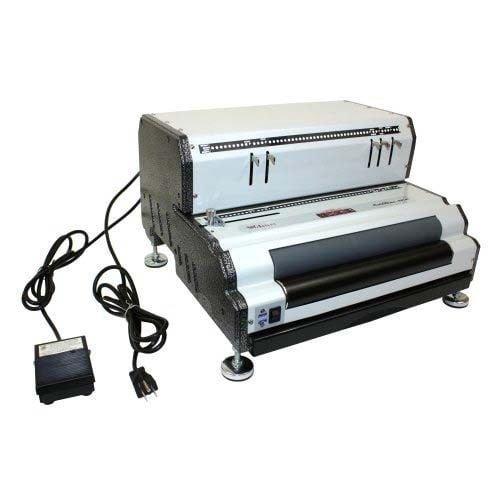
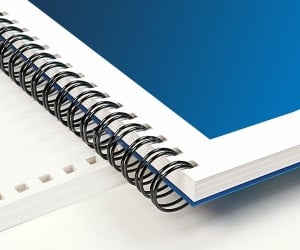
< Over the years, a number of customers have asked me whether they can use twin loop wire with their plastic comb binding machine. These customers often don’t want to have to buy a brand new machine but like the look and feel of twin loop wire binding. However, the answer to their question isn’t as simple as it seems. You see, they actually do make twin loop wire that is designed to work with the plastic comb binding hole pattern. With that said, if you want to use these wires you are going to need a way to close the wires. What is Spiral-O Wire? Let me explain a little bit more…There is a product that we carry called Spiral-O Wire. This wire has 19 loops and is designed to work with the hole pattern from a plastic comb binding machine. Spiral-O Wire is sometimes called Wire Combs or Ibico Wire and was originally designed for use with some of the older Ibico binding machines. A number of the older Ibico plastic comb binding machines also included a twin loop wire closer on the front of them to allow users to use both plastic combs and wire. This 19 loop wire was designed for this purpose. What Equipment is Needed? As the Ibico brand has been phased out by GBC and all of the older Ibico plastic binding machines have been replaced with new models, they no longer have the twin loop wire closer on the front of them. This presents a problem in trying to use these spiral-o wires since you can’t use the wires without a way to close them. One of the only options left is to purchase a Twin Loop wire closer. However, since twin loop wire closers are not incredibly cheap this option usually only appeals to users who have larger electric plastic comb binding machines. Otherwise, it is often advisable to simply buy a low end 3:1 pitch twin loop wire binding machine (the supplies are cheaper). This being said, if you have one of the older Ibico binding machines that has a wire closer included you are in luck. The Spiral-O binding supplies that we carry will work perfectly with your machine and you will be able to use both plastic combs and wire depending on your needs. These Spiral-O binding supplies are available in Black, Silver, White, Blue and Red and in sizes up to 1″ in diameter. If you aren’t sure what type of wire binding supplies that you need to work with your machine simply give us a call. Our trained sales representatives will be glad to help you find the correct supplies for use with your machine.(Read More)
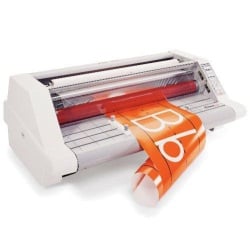

Loading...


